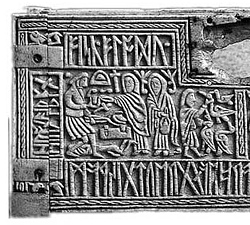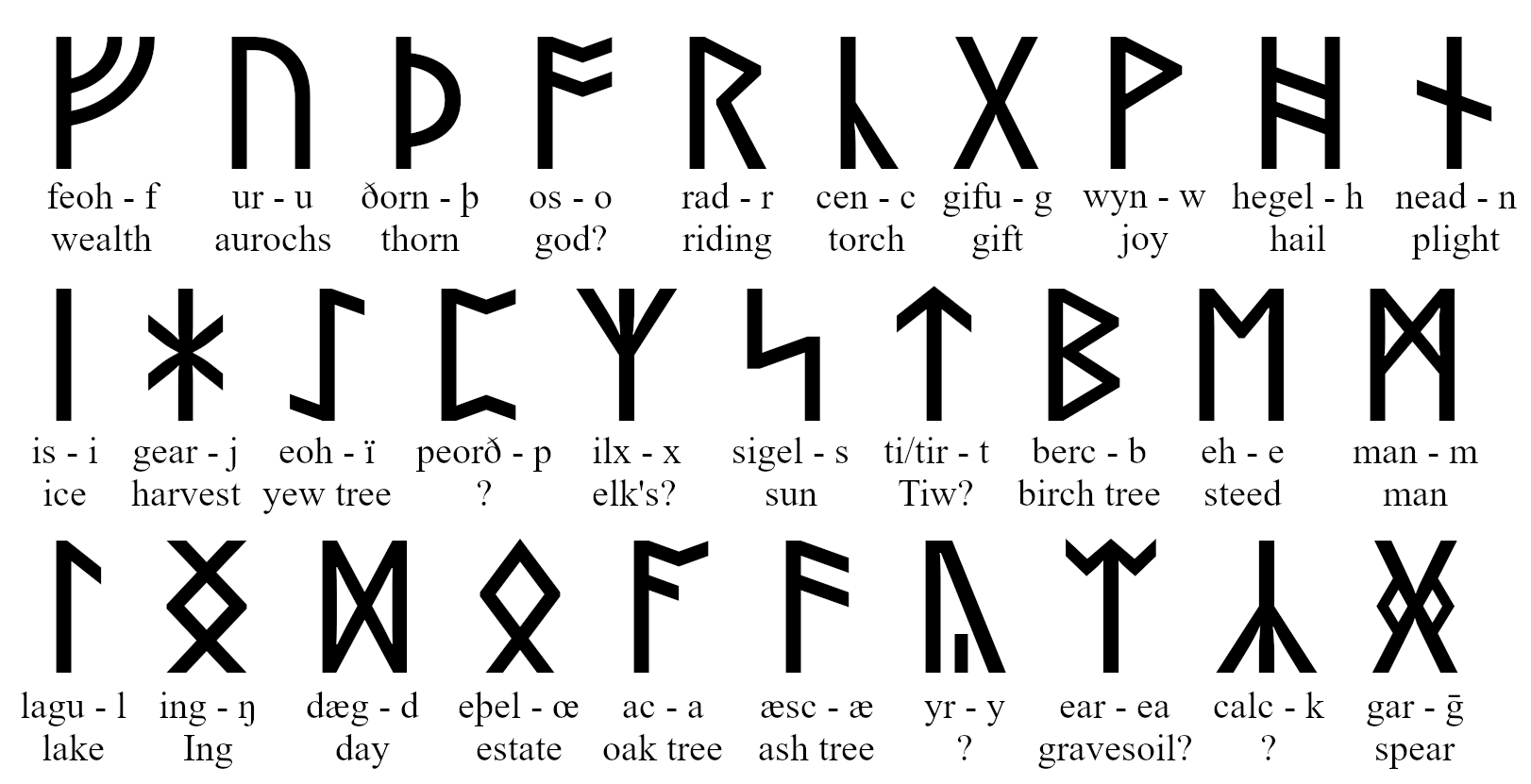|
Armanen Runes
Armanen runes (or ''Armanen Futharkh'') are 18 pseudo-runes, inspired by the historic Younger Futhark runes, invented by Austrian mysticist and Germanic revivalist Guido von List during a state of temporary blindness in 1902, and described in his ''Das Geheimnis der Runen'' ("The Secret of the Runes"), published as a periodical article in 1906, and as a standalone publication in 1908. The name seeks to associate the runes with the postulated Armanen, whom von List saw as ancient Aryan priest-kings. The runes continue in use today in esotericism and in Germanic neopaganism. Publication Von List claimed the pseudo-runes were revealed to him while in an 11-month state of temporary blindness after a cataract operation on both eyes in 1902. This vision in 1902 allegedly opened what List referred to as his "inner eye", via which the "Secret of the Runes" was revealed to him. List stated that his Armanen Futharkh were encrypted in the ''Rúnatal'' of the Poetic Edda (stanzas 138 to ... [...More Info...] [...Related Items...] OR: [Wikipedia] [Google] [Baidu] |
Othala
Othala (), also known as ēðel and odal, is a rune that represents the ''o'' and ''œ'' phonemes in the Elder Futhark and the Anglo-Saxon Futhorc writing systems respectively. Its name is derived from the reconstructed Proto-Germanic *''ōþala-'' "heritage; inheritance, inherited estate". As it does not occur in Younger Futhark, it disappears from the Scandinavian record around the 8th century, but its usage continued in England into the 11th century, where it was sometimes further used in manuscripts as a shorthand for the word ("homeland"), similarly to how other runes were sometimes used at the time. As with other symbols used historically in Europe such as the swastika and Celtic cross, othala has been appropriated by far-right groups such as the Nazi party and neo-Nazis, who have used it to represent ideas like Aryan heritage, a usage that is wholly modern and not attested in any ancient or medieval source. The rune also continues to be used in non-racist contexts, bo ... [...More Info...] [...Related Items...] OR: [Wikipedia] [Google] [Baidu] |
Ansuz (rune)
Ansuz is the conventional name given to the ''a''- rune of the Elder Futhark, . The name is based on Proto-Germanic ''* ansuz'', denoting a deity belonging to the principal pantheon in Germanic paganism. The shape of the rune is likely from Neo-Etruscan ''a'' (), like Latin A ultimately from Phoenician aleph. Name In the Norwegian rune poem, ''óss'' is given a meaning of "estuary" while in the Anglo-Saxon one, takes the Latin meaning of "mouth". The Younger Futhark rune is transliterated as ''ą'' to distinguish it from the new ár rune (ᛅ), which continues the '' jēran'' rune after loss of prevocalic ''*j-'' in Proto-Norse ''*jár'' (Old Saxon ). Since the name of ''a'' is attested in the Gothic alphabet as or , the common Germanic name of the rune may thus either have been ''*ansuz'' "god", or ''*ahsam'' "ear (of wheat)". Development in Anglo-Saxon runes The Anglo-Saxon futhorc split the Elder Futhark ''a'' rune into three independent runes due to the developm ... [...More Info...] [...Related Items...] OR: [Wikipedia] [Google] [Baidu] |
Thurs (rune)
The rune is called Thurs (Old Norse ''Jötunn, Þurs'', a type of entity, from a reconstructed Common Germanic ') in the Icelandic and Norwegian rune poems. In the Anglo-Saxon rune poem it is called thorn, whence the name of the Thorn (letter), letter þ derived. It is transliterated as ''þ'', and has the sound value of a voiceless dental fricative (the Pronunciation of English th, English sound of ''th'' as in ''thing''). The rune is absent from the earliest Vimose inscriptions, but it is found in the Thorsberg chape inscription, dated to ca. AD 200. The rune may have been an original innovation, or it may have been adapted from the History of the Latin alphabet#Classical Latin period, classical Latin alphabet's ''D'', or from the Rhaetic alphabets, Rhaetic's alphabet's ''Θ''. Name In Anglo-Saxon England, the same rune was called ''Thorn'' or "Þorn" and it survives as the Icelandic orthography, Icelandic letter Thorn (letter), Þ (þ). An attempt has been made to accou ... [...More Info...] [...Related Items...] OR: [Wikipedia] [Google] [Baidu] |
Ur (rune)
Ur is the recorded name for the Runes, rune in both Old English and Old Norse, found as the second rune in all futharks (runic alphabets starting with F, U, Þ, Ą, R, K), i.e. the Elder Futhark, Germanic Elder Futhark, the Anglo-Saxon runes, Anglo-Frisian Futhark and the Younger Futhark, Norse Younger Futhark, with continued use in the later medieval runes, early modern runes and Dalecarlian runes. It corresponds to the letter u in the Latin alphabet, but also carries other sound values, especially in Younger Futhark, were its sound values correspond to the vowels: , , and etc., and the consonants: and etc., in the Latin alphabet. Character The character ᚢ may have been derived from the Old Italic scripts, as such features various characters corresponding to Elder Futhark, elder runes, including both upside and downside characters for Upsilon (/u, y/): , , specifically the Rhaetic, East Rhaetic alphabet from the Magrè-region of north-east Italy, which primarily used t ... [...More Info...] [...Related Items...] OR: [Wikipedia] [Google] [Baidu] |
Fe (rune)
Fehu is the reconstructed Proto-Germanic name for the rune (; ), found as the first rune in all futharks (runic alphabets starting with F, U, Þ, Ą, R, K), i.e. the Germanic Elder Futhark, the Anglo-Frisian Futhark and the Norse Younger Futhark, with continued use in the later medieval runes, early modern runes and Dalecarlian runes. It corresponds to the letter f in the Latin alphabet, but it can periodically shift into the sound value of v (compare "leaf" and "leaves"). Character The shape of the rune is likely based on Etruscan ''v'' ⟨𐌅⟩ ⟨⟩, like Greek Digamma ⟨⟩ and Latin ⟨ F⟩ ultimately from Phoenician waw ⟨⟩. The change of the bistaves pointing upward could stem from visually diverging it from the rune ᚨ, as well as linking it visually to the horns of cattle (see ). Name The root name is an ancient word for "livestock". Compare ("livestock, animal"), ("livestock, cattle"), ("livestock"), ("livestock, loose assets"), ("livestoc ... [...More Info...] [...Related Items...] OR: [Wikipedia] [Google] [Baidu] |
Futhorc
Anglo-Saxon runes or Anglo-Frisian runes are runes that were used by the Anglo-Saxons and Medieval Frisians (collectively called Anglo-Frisians) as an alphabet in their native writing system, recording both Old English and Old Frisian (, ᚱᚢᚾᚪ, "rune"). Today, the characters are known collectively as the futhorc (ᚠᚢᚦᚩᚱᚳ, ''fuþorc'') from the sound values of the first six runes. The futhorc was a development from the older co-Germanic 24-character runic alphabet, known today as Elder Futhark, expanding to 28 characters in its older form and up to 34 characters in its younger form. In contemporary Scandinavia, the Elder Futhark developed into a shorter 16-character alphabet, today simply called Younger Futhark. Use of the Anglo-Frisian runes is likely to have started in the 5th century onward and they continued to see use into the High Middle Ages. They were later accompanied and eventually overtaken by the Old English Latin alphabet introduced to Anglo-Sax ... [...More Info...] [...Related Items...] OR: [Wikipedia] [Google] [Baidu] |
Aett
The Scandinavian clan or ''ætt/ätt'' (pronounced in Old Norse) was a social group based on common descent, equivalent to a clan. History In the absence of a police force, the clan was the primary force of security in Norse society, as the clansmen were obliged by honour to avenge one another. The Norse clan was not tied to a certain territory in the same way as a Scottish clan, where the chief owned the territory. The land of the Scandinavian clan was owned by the individuals who had close neighbours from other clans. The name of the clan was derived from its ancestor, often with the addition of an -ung or -ing ending. The original meaning of ''ætt/ätt'' seems to have simply been "those who are related". A person could technically belong to several clans, but usually the identification of an individual came with ancestry of most prestige. Therefore, through mostly the exception to the rule, a clan could have matrilineal name if the descent of the ancestral mother was consi ... [...More Info...] [...Related Items...] OR: [Wikipedia] [Google] [Baidu] |
Stephen Flowers
Stephen Edred Flowers, commonly known as Stephen E. Flowers or his pen name Edred Thorsson, is an American runologist, university lecturer, and proponent of occultism, especially of Neo-Germanic paganism and Odinism. He helped establish the Germanic Neopagan movement in North America and has also been active in left-hand path occult organizations. Flowers has worked to promote the European New Right. Occult career Flowers has established or been associated with the publishing companies named Rûna-Raven Press (c. 1993-2015), Lodestar Books (c. 2011-2019), and Arcana Europa Media (c. 2020-present). As Thorsson, he has been published by Arktos. In the Spring of 1995, due to inner turmoil, Flowers withdrew from any involvement with the Ring of Troth. In August 1995 he and Dawn traveled to Iceland and England to strengthen the work of the Rune-Gild. In April 1996 Flowers retired from his position as Grand Master of the Order of the Trapezoid in order to focus more intently ... [...More Info...] [...Related Items...] OR: [Wikipedia] [Google] [Baidu] |
Anglo-Saxon Runes
Anglo-Saxon runes or Anglo-Frisian runes are runes that were used by the Anglo-Saxons and Medieval Frisians (collectively called Anglo-Frisians) as an alphabet in their native writing system, recording both Old English and Old Frisian (, ᚱᚢᚾᚪ, "rune"). Today, the characters are known collectively as the futhorc (ᚠᚢᚦᚩᚱᚳ, ''fuþorc'') from the sound values of the first six runes. The futhorc was a development from the older Germanic peoples, co-Germanic 24-character runic alphabet, known today as Elder Futhark, expanding to 28 characters in its older form and up to 34 characters in its younger form. In contemporary Scandinavia, the Elder Futhark developed into a shorter 16-character alphabet, today simply called Younger Futhark. Use of the Anglo-Frisian runes is likely to have started in the 5th century onward and they continued to see use into the High Middle Ages. They were later accompanied and eventually overtaken by the Old English Latin alphabet introdu ... [...More Info...] [...Related Items...] OR: [Wikipedia] [Google] [Baidu] |
Old English Language
Old English ( or , or ), or Anglo-Saxon, is the earliest recorded form of the English language, spoken in England and southern and eastern Scotland in the Early Middle Ages. It developed from the languages brought to Great Britain by Anglo-Saxon settlers in the mid-5th century, and the first Old English literature dates from the mid-7th century. After the Norman Conquest of 1066, English was replaced for several centuries by Anglo-Norman (a type of French) as the language of the upper classes. This is regarded as marking the end of the Old English era, since during the subsequent period the English language was heavily influenced by Anglo-Norman, developing into what is now known as Middle English in England and Early Scots in Scotland. Old English developed from a set of Anglo-Frisian or Ingvaeonic dialects originally spoken by Germanic tribes traditionally known as the Angles, Saxons and Jutes. As the Germanic settlers became dominant in England, their language re ... [...More Info...] [...Related Items...] OR: [Wikipedia] [Google] [Baidu] |



